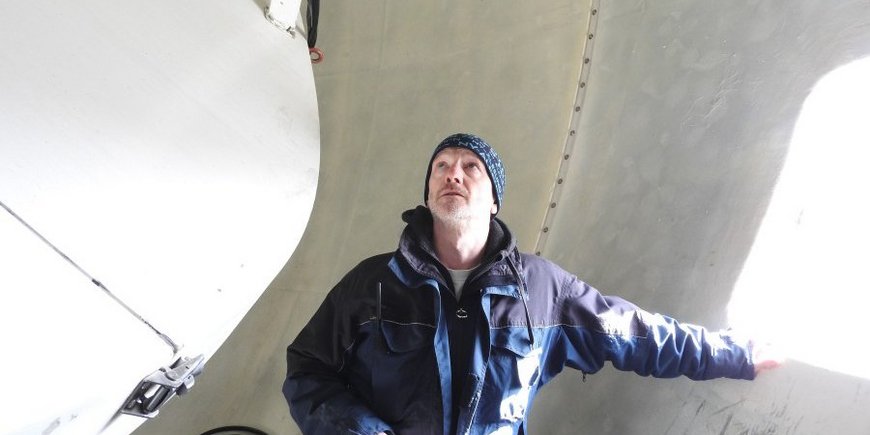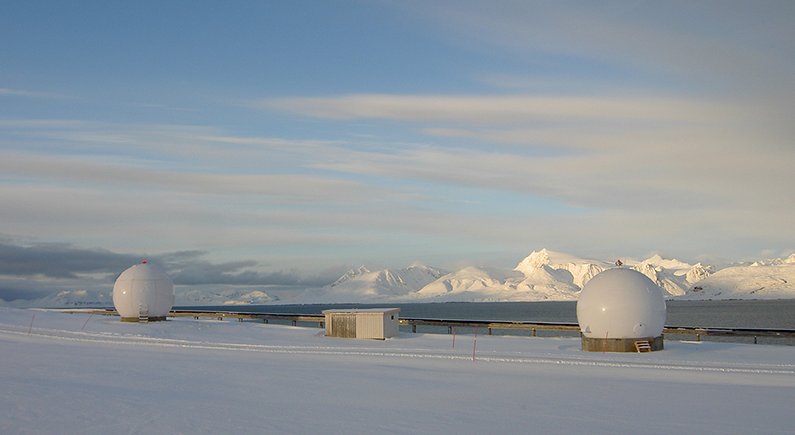Carsten Falck is head of the GFZ Satellite Receiving Station Ny-Ålesund on Spitsbergen. The station receives data from satellites like the GRACE Follow-On mission that was just launched successfully on 22 May this year. The data received at the station are transferred fully automated to the GFZ in Potsdam where they are processed and provided for various purposes.
GFZ: Why did the GFZ decide to install a satellite receiving station on Spitsbergen?
Carsten Falck: The station in Ny-Ålesund on Spitsbergen is located at a distance of only about 1 200 kilometres to the North Pole. This is just perfect for satellites with a polar orbit because we receive their signals at every overflight.
Despite its relatively exotic location Ny-Ålesund can be reached by frequently running planes and ships. Furthermore, with the German-French AWIPEV research base (N.B.: a joint research base of the Alfred-Wegener Institut and the Polar Institute Paul Emile Victor) and the Kingsbay Company we have reliable partner on site since the beginning of operation that support us.
GFZ: Since when is the station running?
Falck: The first antenna was installed in 2001, the second one in 2005.
GFZ: You are working at the GFZ in Potsdam. How often are you in Ny-Ålesund?
Falck: Being almost fully automated the station is all-the-year uncrewed, apart from one visit per year by me and a colleague for maintenance purposes.
Several colleagues from GFZ are permanently involved in operating the station, however. Planning satellite contacts, processing and distributing the data, and monitoring the station is done by the GFZ section Global Geomonitoring and Gravity Field in Potsdam and in the branch office in Oberpfaffenhofen.
GFZ: Which satellites are received by the station?
Falck: Most important are the GRACE-FO satellites, they are always first. As soon as they overfly the station their data are received, no matter which other satellite is around. Besides, there are frequent contacts with the satellites TerraSAR-X and TanDEM-X, which have special GPS receivers on board, provided by GFZ, to determine for example water vapor content of the atmosphere for the improvement of weather forecasts.
It is, however, not only important for us to support large-scale missions but also smaller ones, as well. Currently, we receive data of the Flying Laptop satellite that was built by students from the University of Stuttgart, several times a day, to support the next generation of scientists.
GFZ: What kind of data do you receive besides water vapor?
Falck: First of all, we receive data on the Earth’s gravity field and the Earth’s atmosphere. In addition, also the non-scientific data, for example on the battery status or the status of single instruments, are of importance and always received simultaneously. By this, the satellites can be adjusted optimally and critical changes onboard recognized at an early stage.
GFZ: How soon after receiving the data are you able to provide it for further use?
Falck: The driving force for an immediate provision is the use of the data in weather forecast. The respective data products are produced in GFZ section Space Geodetic Techniques and must be available at weather centres not later than three hours after collection. With a time of circulation of about 95 minutes for a satellite, at best, every circulation must be used for data reception to gain sufficiently recent data.
It is not only about speed, however. Receiving large amounts of data, like those produced by the GRACE-FO mission for example, needs appropriate times of transmission of these data, respectively many contacts per day. These are provided by our station so that all data of the mission can be received.
GFZ: What other applications for the data are there?
Falck: The most important application of data received in Ny-Ålesund is that processed in section Global Geomonitoring and Gravity Field on Earth’s gravity field with a monthly resolution. It is for example used to gain insights in Earth’s hydrologic cycle and used by thousands of applicants on a regular base.
GFZ: The station is the primary receiving station of the GRACE-FO mission. What tasks arise from this fact?
Falck: Before the GRACE-FO mission, data from all kinds of satellites were received in Ny-Ålesund as good as possible, but without immediate obligation. With GRACE-FO the GFZ is in charge of the ground segment of the mission which means that all data must be delivered completely to the project partners like JPL (N.D.: NASA’s Jet Propulsion Laboratory) and German Aerospace Center, immediately after reception.
Like this, the receiving station is for the first time in duty. Thus it had to follow a long way of preparation. One example is the test of one of the station’s receivers that was de-installed in Ny-Ålesund to be tested together with one of the satellites under construction at the manufacturer Airbus in Friedrichshafen.
But the effort paid out. The station convinced critical NASA experts. And when the mission was launched first GRACE-FO signals were already received 80 minutes after the start, in their first orbit. Now the station fulfills its routine operation duties dependably, with about 15 contacts to GRACE-FO per day.
Interview: Jacob Schmidt (Intern Media and Communications), Ariane Kujau
Section Global Geomonitoring and Gravity Field
Section Space Geodetoc Techniques
The station is part of the GFZ Modular Earth Science Infrastruktur (MESI)









![[Translate to English:] Torsten Sachs in front of a climate station on a field](/fileadmin/_processed_/3/9/csm__TorstenSachs_bearbeitet_GS_4a1365ef84.jpeg)

![[Translate to English:] left image flood at the Ahrtal: image from above, several houses are flooded; left image:: Heidi Kreibich;](/fileadmin/_processed_/4/4/csm_Bild2_9af0130e9f.png)



![[Translate to English:] Start der Vega Rakete](/fileadmin/_processed_/6/4/csm_20231201-kachel_Vega-VV23-launch_ESA-CNES-Arianespace_706716b68c.jpeg)









![[Translate to English:] Poster exhibition at the Brandenburg Hydrogen Day at the GFZ, some participants in the foreground](/fileadmin/_processed_/6/5/csm_Erster_Brandenburgischer_Wasserstofftag_GFZ_402fcec95e.jpeg)
![[Translate to English:] Group picture of the participants](/fileadmin/_processed_/9/4/csm_20231108_CAWa-Workshop-Tashkent_Gruppenbild_99ea779d8a.jpeg)

![[Translate to English:] [Translate to English:] Hörsaal](/fileadmin/_processed_/e/6/csm_H%C3%B6rsal_e21ac645fb.jpeg)


![[Translate to English:] The Delegations in the Historic Library on the Telegrafenberg. In the back there are from left to right, the Dutch Ambassador for Germany, Ronald van Roeden, the Dutch Minister for Education, Culture and Science, Robbert Dijkgraaf and the scientific director of the GFZ, Susanne Buiter.](/fileadmin/_processed_/d/b/csm_Kachel-2_9eba4b4212.jpeg)

